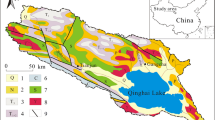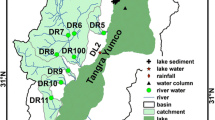Abstract
The major cations and anions from lake water samples and its sources, including glacier snow, precipitation, stream, and swamp water in the Nam Co basin, central Tibetan Plateau, were studied. The concentrations of the major ions varied significantly in the five environmental matrices. Generally, the mean concentrations of most ions are in the order of lake water > swamp water > stream water > precipitation > snow. Rock weathering is the dominant process controlling the chemical compositions of the stream and swamp waters, with carbonate weathering being the primary source of the dissolved ions. The Nam Co lake water is characterized by high Na+ concentration and extremely low Ca2+ concentration relative to other ions, resulting from evapoconcentration and chemical precipitation within the lake. Comparison with the water chemistry of other lakes over the Tibetan Plateau indicated that Nam Co is located in a transition area between non-saline lakes and highly saline lakes. The relatively low concentration of total dissolved solids is possibly due to the abundant inflow of glacial meltwater and relatively high annual precipitation.




Similar content being viewed by others
References
Banks D, Parnachev VP, Frengstad B, Holden W, Karnachuk OV, Vedernikov AA (2004) The evolution of alkaline, saline ground- and surface waters in the southern Siberian steppes. Appl Geochem 19(12):1905–1926. doi:10.1016/j.apgeochem.2004.05.009
Berner EK, Berner RA (1996) Global environment: water, air, and geochemical cycles. Prentice Hall, New Jersey
Brown GH, Sharp M, Tranter M (1996) Subglacial chemical erosion: seasonal variations in solute provenance, Haut Glacier d’Arolla, Valais, Switzerland. In: Collins D (ed) Annals of glaciology, vol 22. Proceedings of the international symposium on glacial erosion and sedimentation. Annals of glaciology, pp 25–31
CAS (1982) Physical geography of Xizang (Tibet). Science Press, Beijing
CAS (1984) Rivers and Lakes of Xizang(Tibet). Science Press, Beijing
Chen JS, Wang FY, Xia XH, Zhang LT (2002) Major element chemistry of the Changjiang (Yangtze River). Chem Geol 187(3–4):231–255. doi:10.1016/S0009-2541(02)00032-3
Chen JS, Wang FY, Meybeck M, He DW, Xia XH, Zhang LT (2005) Spatial and temporal analysis of water chemistry records (1958-2000) in the Huanghe (Yellow River) basin. Glob Biogeochem Cycles 19(3). doi:10.1029/2004GB002325
Cong ZY, Kang SC, Liu XD, Wang GF (2007) Elemental composition of aerosol in the Nam Co region, Tibetan Plateau, during summer monsoon season. Atmos Environ 41(6):1180–1187. doi:10.1016/j.atmosenv.2006.09.046
Fortner SK, Tranter M, Fountain A, Lyons WB, Welch KA (2005) The geochemistry of supraglacial streams of Canada Glacier, Taylor Valley (Antarctica), and their evolution into proglacial waters. Aquat Geochem 11(4):391–412. doi:10.1007/s10498-004-7373-2
Garrels RM, Mackenzie FT (1971) Evolution of sedimentary rocks. Norton, New York
Gibbs RJ (1970) Mechanisms controlling world water chemistry. Science 170:1088–1090. doi:10.1126/science.170.3962.1088
Ju JT, Zhu LP, Wang Y, Xie MP, Peng P, Zhen XL Wang JB (in press) Preliminary research on composition, spatial distribution, and environmental significance of water ions in Pumayum Co lake and its catchment, South Tibet. J Geogr Sci
Kapp JLD, Harrison TM, Kapp P, Grove M, Lovera OM, Lin D (2005) Nyainqentanglha Shan: a window into the tectonic, thermal, and geochemical evolution of the Lhasa block, southern Tibet. J Geophys Res Solid Earth 110(B8). doi:10.1029/2004JB003330
Kutzbach JE, Guetter PJ, Ruddiman WF, Prell WL (1989) Sensitivity of climate to late Cenozoic uplift in southern Asia and the American West: numerical experiments. J Geophys Res 94(D15):18393–18407. doi:10.1029/JD094iD15p18393
Li C, Kang SC, Zhang QG, Kaspari S (2007a) Major ionic composition of precipitation in the Nam Co region, Central Tibetan Plateau. Atmos Res 85(3–4):351–360. doi:10.1016/j.atmosres.2007.02.006
Li CL, Kang S, Cong ZY (2007b) Elemental composition of aerosols collected in the glacier area on Mt. Nyainqêntanglha, Tibetan Plateau, during summer monsoon season. Chin Sci Bull 52(24):3436–3442. doi:10.1007/s11434-007-0445-0
Li CL, Kang SC, Wang XP, Ajmone-Marsan F, Zhang QG (2008) Heavy metals and rare earth elements (REEs) in soil from the Nam Co Basin, Tibetan Plateau. Environ Geol 53:1433–1440. doi:10.1007/s00254-007-0752-4
Li M, Kang S, Zhu L, You Q, Zhang Q, Wang J (2008) Mineralogy and geochemistry of the Holocene Lacustrine sediments in Nam Co, Tibet. Quaternary Int 187(1):105–116. doi:10.1016/j.quaint.2007.12.008
LIZIG (1979) Qinghai Lake monograph of the 1961 expedition. Science Press, Beijing
Molnar P, England P, Martinod J (1993) Mantle dynamics, uplift of the Tibetan plateau, and the Indian monsoon. Rev Geophys 31(4):357–396. doi:10.1029/93RG02030
Mügler I, Sachse D, Werner M, Xu B, Wu G, Yao T, Gleixner G (2008) Effect of lake evaporation on δD values of lacustrine n-alkanes: a comparison of Nam Co (Tibetan Plateau) and Holzmaar (Germany). Org Geochem 39(6):711–729. doi:10.1016/j.orggeochem.2008.02.008
Pandey SK, Singh AK, Hasnain SI (1999) Weathering and geochemical processes controlling solute acquisition in Ganga headwater-Bhagirathi river, Garhwal Himalaya, India. Aquat Geochem 5(4):357–379. doi:10.1023/A:1009698016548
Qian H, Ma ZY (2005) Hydrogeology and geochemistry. Geological Press, Beijing
Rowley DB, Currie BS (2006) Palaeo-altimetry of the late Eocene to Miocene Lunpola basin, central Tibet. Nature 439(7077):677–681. doi:10.1038/nature04506
Sarin MM, Krishnaswami S, Dilli K, Somayajulu BLK, Moore WS (1989) Major ion chemistry of the Ganga-Brahmaputra river system: weathering processes and fluxes to the Bay of Bengal. Geochim Cosmochim Acta 53:997–1009. doi:10.1016/0016-7037(89)90205-6
Shao ZG, Meng XG, Zhu DG, Wang J, Yang CB, Han JE et al (2004) Variation of precipitation in Nam Co, Tibet, since the late Pleistocene and its environmental response. J Geom 10(4):337–343 (in Chinese)
Singh AK, Hasnain SI (2002) Aspects of weathering and solute acquisition processes controlling chemistry of sub-Alpine proglacial streams of Garhwal Himalaya, India. Hydrol Process 16(4):835–849. doi:10.1002/hyp.367
Stallard RF, Edmond JM (1983) Geochemistry of the Amazon: the influence of the geology and weathering environment on the dissolved load. J Geophys Res 88:9671–9688. doi:10.1029/JC088iC14p09671
Stumm W (1992) Chemistry of the solid–water interface. Wiley, New York
Wang SM, Dou HS (1998) Directory of lakes in China. Science Press, Beijing
Wang R, Yang XD, Zhu LP (2006) Environmental changes of Nam Co, Xizang, during the past 200 years. Quaternary Sci 26(5):791–798 (in Chinese)
Yan JP, Hinderer M, Einsele G (2002) Geochemical evolution of closed-basin lakes: general model and application to Lakes Qinghai and Turkana. Sediment Geol 148(1–2):105–122. doi:10.1016/S0037-0738(01)00212-3
Yang XD, Kamenik C, Schmidt R, Wang SM (2003) Diatom-based conductivity and water-level inference models from eastern Tibetan (Qinghai-Xizang) Plateau lakes. J Paleolimnol 30(1):1–19. doi:10.1023/A:1024703012475
Yuan J, Gao JX, Lu XG, Chen KL (2002) Assessment of wetland resources in Lake Nam Co and Counter measures for conservation and rational use. Resour Sci 24(4):29–34 (in Chinese)
Zhao XT, Zhu DG, Yan FH, Wu ZH, Ma ZB, Mai XS (2003) Climatic change and lake-level variation of Nam Co. Xiang since the last interglacial stage. Quaternary Sci 23:41–52 (in Chinese)
Zhu DG, Meng XG, Zhao XT, Shao ZG, Yang CB, Ma ZB et al (2004) Evolution and climatic change of Nam Co of Tibet and an ancient large lake in the northern Tibetan Plateau since the late Pleistocene. Geol China 31:269–277 (in Chinese)
Acknowledgments
We thank Zhiyuan Cong and the staff of NAMOR for their assistance in field logistics. This study was supported by the National Natural Science Foundation of China (40771187), the National Basic Research program of China (2005CB422004), the “Talent Project” of the Chinese Academy of Sciences.
Author information
Authors and Affiliations
Corresponding author
Rights and permissions
About this article
Cite this article
Zhang, Q., Kang, S., Wang, F. et al. Major Ion Geochemistry of Nam Co Lake and its Sources, Tibetan Plateau. Aquat Geochem 14, 321–336 (2008). https://doi.org/10.1007/s10498-008-9039-y
Received:
Accepted:
Published:
Issue Date:
DOI: https://doi.org/10.1007/s10498-008-9039-y




